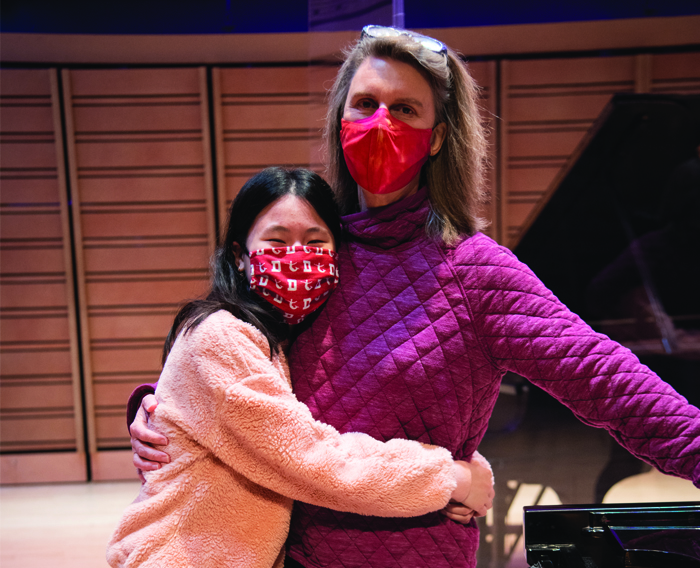Dickinson Music Department Finds Creative Way to Stage Orchestra Concert During Pandemic

Ruby Ngo '22 (left) and Professor of Music Jennifer Blyth.
Learn the story behind an unlikely May 9 performance
by MaryAlice Bitts-Jackson
This is the story of a professor, a student and a tradition that wasn't likely to happen during a pandemic year. The professor is Jennifer Blyth, and the student is Ruby Ngo ’22, a pianist who majors in music and quantitative economics. The tradition is Dickinson’s spring Concerto Competition/Orchestra Concert, which includes a solo performance by the winner of the fall Concerto Competition—this year, that's Ngo.
Performances are degree requirements for music majors like Ngo, and during the past year, Dickinson’s music department has found creative ways to safely make solo and small-group performances happen. But could the Dickinson musicians pull off a much more complex, full-orchestra event during a pandemic? At the end of a challenging year—for ensemble musicians, music educators and students everywhere, and for this student-soloist in particular—Dickinson's music department was determined to find out.
“Ruby is really a perfect student—she’s always looking for ways to improve and learn. We wanted to honor her hard work and accomplishments,” says Blyth, noting that Ngo, a recipient of the Truman Bullard Scholarship for students who show exceptional promise in music, showed remarkable perseverance and grace during the past year as an international student from Vietnam unable to return home since the start of the pandemic. “We had no idea if we could actually make this work, but we knew we needed to try.”
Uncharted territory
The fall competition was relatively easy: To level the playing field, the music department had sent identical microphones to each student contestant so they could achieve comparable sound quality as they recorded their performances from home. Ngo was named the winner for her dynamic execution of Edvard Grieg’s "Piano Concerto in A minor Op. 16."
But Blyth and her colleagues knew they couldn’t safely host a live orchestra performance in the spring. In-person rehearsals were also impossible. The orchestra was too large to be positioned with members at a safe distance from each other on the Rubendall stage, the brass and wind instrumentalists cannot play while masked, and the student-musicians weren’t all on campus during the partially remote spring semester.
Remote technologies like Zoom wouldn’t work: The time lags and glitches that make meetings annoying wreak havoc for musicians, struggling to play together in time. The only way was to solicit remotely pre-recorded performances for both the fall competition and the spring orchestra concert.
Getting musicians to record performances from home was one thing. Getting them to produce quality sound recordings that were perfectly in time—and then blending those recordings into a whole—was quite another.
Facing the music
Seven faculty members came together in Rubendall Recital Hall—facemasks in place, sitting six feet apart and behind plexiglass—to record a bare-bones recording of the Grieg concerto. One faculty member conducted. Five others performed the principal violin (I, II), viola, cello and bass parts, and Blyth filled in with additional parts—timpani, brass instruments and so on—on the piano. Ngo recorded her solo.
The music department sent this click-track recording to all of the orchestra musicians, who listened to it as they recorded their parts from home. That kept everyone in sync. Because the orchestra is smaller during the pandemic, faculty members recorded more than one track for each instrument so that all of the parts—cello I, II and III, for example—were covered.
The department’s recording technician, Patrick Oh, stitched all of these recordings together, matching beat to beat, and mixed the sound levels to perfection, at times deploying reverb to make the sound more natural and to address varying sound quality. He also seamlessly blended individual vocal performances by students, faculty, community members and roughly 35 alumni in the Dickinson College Choir as they performed from their homes across the country and around the world.
“Although the musicians didn’t have professional recording circumstances, they had the talent to overcome that situation,” Oh says.
Showtime!
The Dickinson Orchestra will present its concerto-competition performance in a joint concert with Dickinson's jazz and chamber-music musicians on May 9.
It's a fitting cap to an eventful year for Dickinson’s arts departments, as professors and students alike learned to create and share art in new ways. The music department livestreams performances on its YouTube channel, collaborates with theatre & dance on virtual productions, provides recorded performances for remote college events, like the recent Scholarship Celebration (which featured a Ngo) and the upcoming Commencement, and runs a student-led Make Music Any Way program to provide remote music education to area students during the pandemic.
“This is what a Dickinson education is all about: showcasing how to be resourceful and adaptable by applying critical thinking and imagination,” says Blyth.
Also important: the human connections driving these innovations forward. Ngo says she’s grateful for the close bonds that arise from small classes, group rehearsals and performances, and one-on-one lessons.
“Piano lessons with Professor Blyth during this crazy pandemic are those times that I looked forward to the most,” she says. “I really love her as a person—not just as a professor, but as my friend.”
The Dickinson Orchestra, Jazz Ensemble and chamber music program present the joint concert, featuring Ngo's solo, on the music department’s YouTube channel at 4 p.m. on Sunday, May 9.
TAKE THE NEXT STEPS
Published May 6, 2021